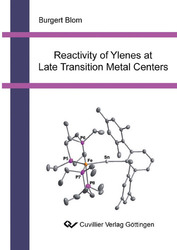| Fachbereiche | |
|---|---|
| Buchreihen (96) |
1378
|
| Nachhaltigkeit |
3
|
| Gesundheitswesen |
1
|
| Geisteswissenschaften |
2364
|
| Naturwissenschaften |
5406
|
| Mathematik | 229 |
| Informatik | 319 |
| Physik | 980 |
| Chemie | 1363 |
| Geowissenschaften | 131 |
| Humanmedizin | 243 |
| Zahn-, Mund- und Kieferheilkunde | 10 |
| Veterinärmedizin | 108 |
| Pharmazie | 147 |
| Biologie | 835 |
| Biochemie, Molekularbiologie, Gentechnologie | 121 |
| Biophysik | 25 |
| Ernährungs- und Haushaltswissenschaften | 45 |
| Land- und Agrarwissenschaften | 1004 |
| Forstwissenschaften | 201 |
| Gartenbauwissenschaft | 20 |
| Umweltforschung, Ökologie und Landespflege | 148 |
| Ingenieurwissenschaften |
1793
|
| Allgemein |
98
|
|
Leitlinien Unfallchirurgie
5. Auflage bestellen |
|
Erweiterte Suche
Reactivity of Ylenes at Late Transition Metal Centers
Burgert Blom (Autor)Vorschau
Inhaltsverzeichnis, Datei (77 KB)
Leseprobe, Datei (140 KB)
Heavy main group elements, i.e. those where n > 2, exhibit a marked decreasing propensity to engage in pi- bond formation compared to the lighter elements. This presents a huge challenge in contemporary inorganic chemistry and in terms of triple bonding between heavy main group elements and transition metals, reports are rare. In fact, there are only a few examples of complexes featuring triple bond formation to the heavier homologues of carbon (Si – Pb), and in all these cases the transition metal is always a member of group 6 (Cr, Mo, W).
This dissertation explores the general reactivity of Power-type ylenes: [EXR] (where E = Ge, Sn and Pb; X = Cl or Br; and R = a bulky m-terphenyl substituent) towards a range of late transition metal complexes in group 8, 9 and 10 with the overall goal of making triple bonds between Ge – Pb with these late transition metal element atoms, hitherto unprecedented.
The work described here uncovered the first examples of any transition metal beyond group 6 (Fe) engaging in a triple bond interaction to any heavy homologue of carbon.
| ISBN-13 (Printausgabe) | 3869559071 |
| ISBN-13 (Printausgabe) | 9783869559070 |
| ISBN-13 (E-Book) | 9783736939073 |
| Buchendformat | A5 |
| Sprache | Englisch |
| Seitenanzahl | 308 |
| Umschlagkaschierung | glänzend |
| Auflage | 1 Aufl. |
| Band | 0 |
| Erscheinungsort | Göttingen |
| Promotionsort | Bonn |
| Erscheinungsdatum | 31.10.2011 |
| Allgemeine Einordnung | Dissertation |
| Fachbereiche |
Chemie
|








